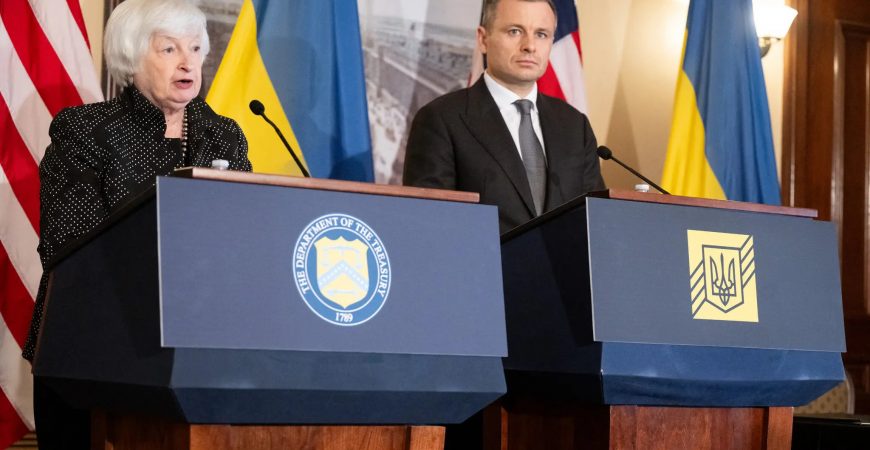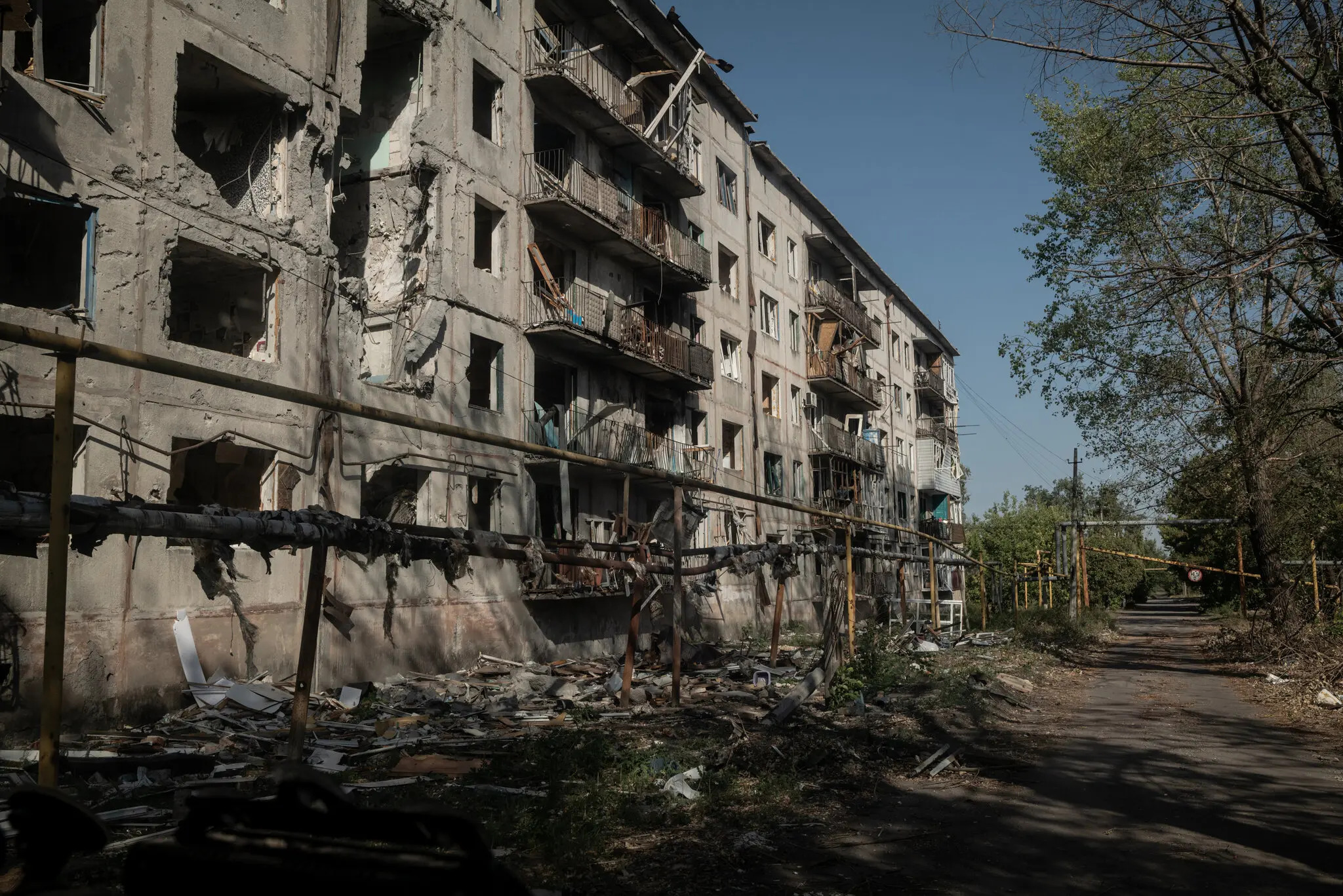
The Group of 7 nations finalized a plan to give Ukraine a $50 billion loan using Russia’s frozen central bank assets, Biden administration officials said on Wednesday.
The loan represents an extraordinary maneuver by Western nations to essentially force Russia to pay for the damage it is inflicting on Ukraine through a war that shows no sign of ending.
“These loans will support the people of Ukraine as they defend and rebuild their country,” President Biden said in a statement. “And our efforts make it clear: Tyrants will be responsible for the damages they cause.”
The announcement comes after months of debate and negotiation among policymakers in the United States and Europe over how they could use $300 billion of frozen Russian central bank assets to support Ukraine.
The United States and the European Union enacted sanctions to freeze Russia’s central bank assets, most of which are held in Europe, after its invasion of Ukraine in early 2022. As the war dragged on, officials in the United States pushed for the funds to be seized and given directly to Ukraine to aid in its economic recovery.
European officials had concerns about the lawfulness of such a move, however, and both sides eventually agreed over the summer that they would use the interest that the assets were earning to back a $50 billion loan.
“Never before has a multilateral coalition frozen the assets of an aggressor country and then harnessed the value of those assets to fund the defense of the aggrieved party,” Daleep Singh, the White House’s deputy national security adviser for international economics, said on Wednesday.
Mr. Singh said that the United States would contribute $20 billion to the $50 billion loan and that the European Union, Britain, Canada and Japan would contribute the rest.

More than $200 billion worth of Russian reserves are held by Belgium’s central securities depository, Euroclear. The assets are generating more than $3 billion a year of interest, which will be used to pay off the loan over time.
The process of constructing the loan had stalled in recent months over various technical details and legal obstacles. The United States was aiming to find a way to contribute to the loan without having to ask Congress for more money.
To do that, the United States needed assurances from the European Union that the sanctions it was using to freeze Russia’s assets would remain in place, so that the interest being generated from that money — and not U.S. taxpayers — would repay the loan. The U.S. government is able to offer loans to countries if there is a high level of certainty that the money will be repaid.
The U.S. contribution will be dedicated toward economic assistance unless Congress gives the Biden administration permission to allow a portion of the loan to be used for military assistance. The Biden administration is asking Congress to make the necessary legislative changes before mid-December, otherwise it will provide the full $20 billion as economic aid.
At least half of the U.S. funds will be distributed to Ukraine later this year through a World Bank trust fund. The loan will come from the U.S. Federal Financing Bank, which is overseen by the Treasury Department, and will be guaranteed by the United States Agency for International Development.
Jacob Kirkegaard, a senior fellow at the Peterson Institute for International Economics in Brussels, said the agreement on the loan highlighted the strength of the support among the Group of 7 countries for Ukraine, despite the perception that they were becoming fatigued with the war.
“We are moving away from not just providing support for Ukraine to actually punishing Russia,” Mr. Kirkegaard said. “We should remember that this money is legally, in principle, still Russian money, and they’re now funding their enemy.”
Mr. Kirkegaard said he thought it made it less likely that the West would abandon Ukraine at some point down the line, since they had already greenlighted spending Russian money, even if former President Donald J. Trump were to win the 2024 election. If Mr. Trump comes to office and tries to stop aid to Ukraine, putting more pressure on E.U. countries to make up for it, “I am certain the issue of outright seizure of the Russian assets held in the E.U. will be up for discussion again,” he said.
Officials have been racing to finalize the terms of the loan in order to deliver Ukraine another economic lifeline by the end of the year.
On Wednesday, Treasury Secretary Janet L. Yellen met with Ukraine’s finance minister, Serhiy Marchenko, in Washington to sign documents related to the terms of the loan.
“This loan initiative will provide Ukraine with urgently needed funds and will make funds available by the end of this year,” Ms. Yellen said. “It will send a message to Putin that waiting out our coalition is a losing strategy.”
The Treasury secretary said that because the loan would be repaid using interest from Russian assets, “Russia will increasingly be forced to bear the costs of its illegal war, instead of taxpayers in the U.S. and Europe.”
Mr. Marchenko said the loan was a “tremendous decision” that would demonstrate to aggressors that they would have to pay for invading democracies. He also suggested that he hoped the loan would be a step toward the Group of 7 seizing the full amount of Russia’s frozen assets.
Britain will contribute $3 billion to the loan, Chancellor Rachel Reeves said on Tuesday. The loan is earmarked for military equipment, including artillery and air defense systems.
“Our support for Ukraine and her men and women in their fight for freedom from Putin’s aggression is unwavering and will remain so for as long as it takes,” Ms. Reeves said.
The European Parliament on Tuesday approved the E.U. loan, which it authorized to be as large as $39 billion, and comes as Ukraine is running out of money, both for weapons and for rebuilding energy infrastructure as it heads into another winter.
Ursula von der Leyen, the president of the European Commission, said last month that Europe was willing to move ahead with the loan even before the United States specified its contribution. The European Union is expected to reduce its share of the loan from $39 billion if the United States contributes $20 billion, as was originally planned.
A sticking point in negotiations was that Hungary had blocked changes requested by Washington that the European Union extend the period during which sanctions against Russia were reviewed from every six months to every 36 months. Two-thirds of Russia’s central bank assets are held in E.U. countries, and any change in the sanctions could unlock the Russian assets that serve as the basis of the loan.
Mr. Singh said that the United States had received sufficient assurances from the European Union that the loan was secure and that the terms of the loan would require Russia to repay it if a truce were to be reached.
Russia has sharply criticized the freezing of its central bank assets, threatening legal action and reprisals if its reserves are given to Ukraine.
The Group of 7 believes that the loan does not violate international law because the interest that is being earned on the Russian assets does not belong to Russia.
©washingtonnewsworld.com